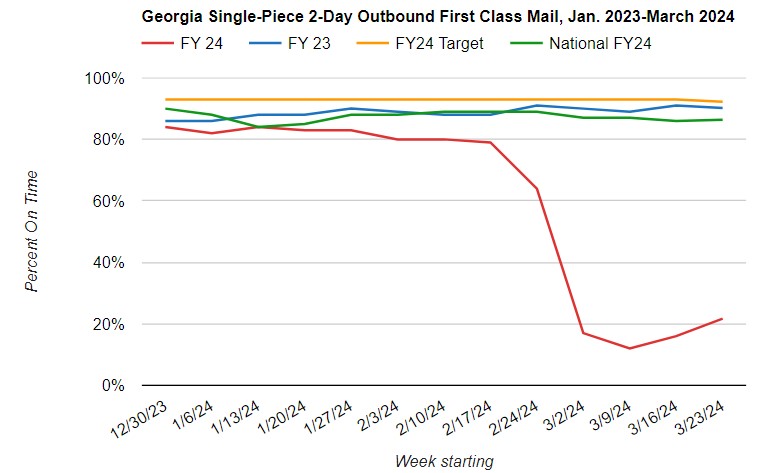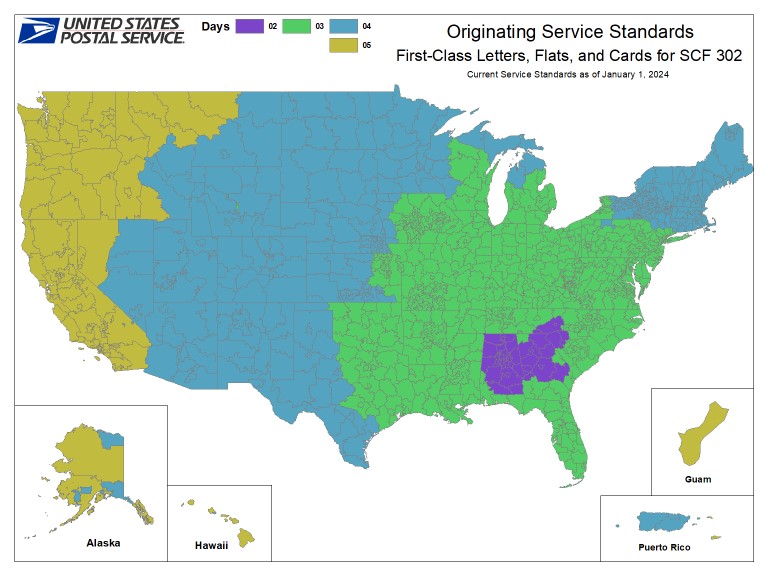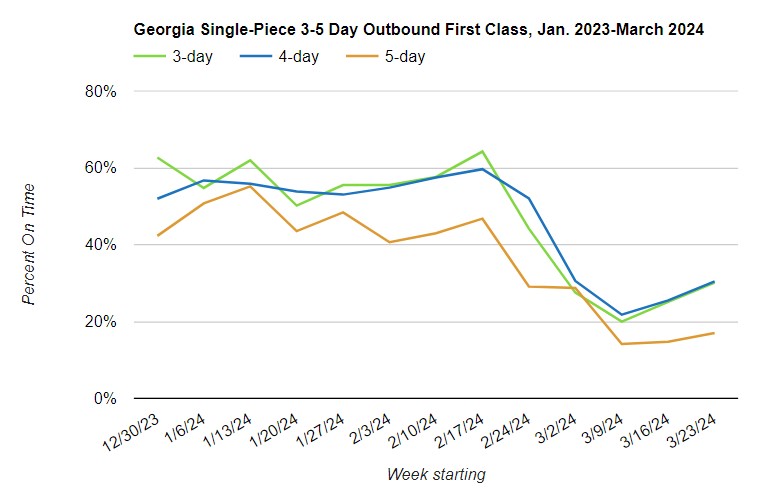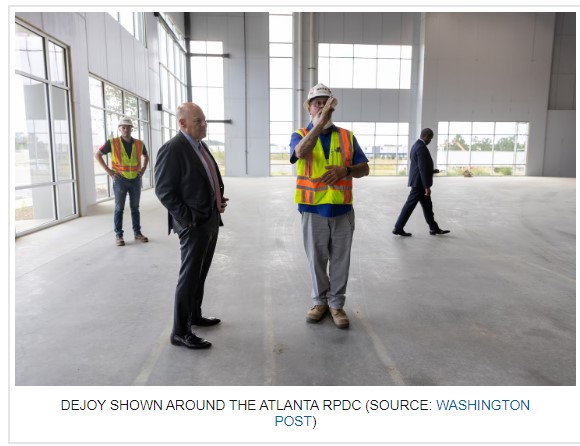Where the 2024 Presidential Election Voting Integrity Will Be Fought
Atlanta USPS Regional Processing and Distribution Centers crashes on launch
by Steve Hutkins
This is a long post. It is the only way Steve can get it across the issues created by Louis Dejoy’s incompetence. Look out 2024 Presidential Election, we will have a battle on our hands. Think of SCOTUS.
With the botched-up implementation of the new USPS Processing and Distribution Centers going on the way they are, we will see significant issues with the upcoming 2024 presidential elections. Time to stop the implementation and take alternative precautions to insure postal deliveries. And Fire Louis DeJoy.
Below? A picture of the person who “may” have the biggest impact on the 2024 election. All dressed out in a suit in a USPS Regional Processing & Distribution Center. I am sure the USPS workers were impressed.
Angry Bear already posted Steve Hutkins reveal on how the Richmond facility has had severe implementation issues. The Atlanta facility was just starting the conversion process. What was considered a dumpster fire in the past is now being called a House Fire in Atlanta. The rate of on-time delivery of mail went from 60-70% to roughly 20%. And there is Post Master General Louis DeJoy just smiling away.
~~~~~~~~
Steve: July 2023, the first Regional Processing & Distribution Center opened in Richmond, Virginia. The launch ran into problems, and mail delays have plagued the region for months. The Postal Service said it would learn from its mistakes and the next RPDC rollouts would go more smoothly. Another RPDC opened a few weeks ago in Atlanta. The mail delays have been worse than in Richmond, much worse.
There was an open house celebrating the new Atlanta RPDC in Palmetto during the week of February 21. That same week, service performance in the Georgia district began to drop, and it just kept dropping. During the second week of March, on-time scores for First Class mail had fallen to 25 percent. Below, a chart showing on-time scores for First Class since the beginning of the year. (The data come from the USPS Service Performance Dashboard.)
The graph shows the composite scores for First Class mail, much of which is pre-sort mail that moves relatively quickly through the network. If one looks just at single-piece mail, the drop in performance is even more pronounced. Here’s the graph for Georgia, single-piece (outbound) First Class Mail with a 2-day service standard.
Shortly after the Atlanta RPDC opened in February 2024, the scores for 2-day mail fell off and continued to fall, all the way down to 12 percent. That’s as low as scores have ever been, anywhere. About the best one can say about them is that they may have bottomed out in mid-March.
It doesn’t get much better when one looks at single-piece First Class with a 3, 4, and 5-day standard.
Here’s the service standard map for mail originating in the Atlanta (302) showing the regions of the country that should get the mail in 2, 3, 4, and 5 days. (Everything was 2-day and 3-day before DeJoy lowered service standards in 2021 to cut costs by eliminating the use of planes.)
Here’s a graph showing the on-time scores for single-piece mail with a 3, 4, and 5 day service standard since the beginning of the year.
When the Postal Service presented its case for changing the service standards to the Postal Regulatory Commission, it claimed that under the relaxed standards it would be able to achieve 95 percent on-time, across the board. That hasn’t happened nationwide, and it clearly hasn’t happened in Georgia, where scores this year for 3-5 day mail were in the 40-60 percent range before the RPDC launch and 20-30 percent after launch.
Another metric for looking at service performance is average days to deliver. The Postal Service likes to boast that the weekly average is about 2.5 days for the entire mail stream. For mail with a 2-day standard, the average is typically somewhat less than 2 days, since some mail is delivered faster than the standard.
After the Atlanta RPDC opened, the average days to deliver increased dramatically. Here’s a chart showing average days to deliver for 2-day mail over the past three months and for the same period last year.
Given that these are averages, it’s likely that much of this 2-day mail took more than 10 days to reach its destination. In some cases, the mail piece may have just been going across town.
Similar but not so severe problems happened when the Richmond RPDC opened in July 2023. This chart shows monthly scores for single-piece First Class for the Virginia District, along with the scores for the same period last year and for the nation.
The monthly scores for Virginia track close to the previous year and nation — about 85 percent on time. After the Richmond RPDC opened, Virginia’s scores dropped to 76 percent in August, improved in September, then began dropping again. By December, monthly scores had hit bottom at about 55 percent on time. During the third week of December, the weekly score for all single-piece First Class was down to 49 percent on time, and the 3-day mail was down to 43 percent.
Virginia’s scores remain below last year’s, but they have improved. The scores in Georgia showed an uptick during the week of March 23, so perhaps the worst is over. But at this point it’s not clear how long will it take for scores to get back to anything like normal.
The most recent data on the USPS Service Performance Dashboard is for the week of March 23-30. Snailworks, a company that tracks service performance, says this about on-time delivery during the first week of April:
“First-Class delivery times remain dismal, with Atlanta GA area facilities dragging down averages. Nationally, only 69.2% of First-Class letters were delivered on time, with 7.5% more than five days late. It still took about 12 days for a letter to be delivered to an Atlanta address.”
A dumpster fire
One of the goals of the network transformation is to make it possible to deliver packages on a same-day or next-day basis. Slides in USPS presentations show how many customers can be served within service areas based on their distance from a processing center — the closer you are, the faster the service.
But far from improving delivery times, the rollout in Georgia has caused unprecedented delays. As Leo Raymond, a former USPS manager and director of Mailers Hub, put it to NBC last week, “It’s just a dumpster fire right now.”
Not surprisingly, the delays are impacting newspaper delivery. The Pickens Progress (which serves a county north of Atlanta) reports that since the opening of the RPDC the “phones at our office and newspaper offices throughout the state have been ringing off the hook with upset customers whose newspapers haven’t been delivered.”
Concerns are also mounting over election mail. A couple of weeks ago, 11Alive in Atlanta reported that Georgia Secretary of State’s Office said postal problems are affecting election mail.
“11Alive heard from voters across metro Atlanta who expressed similar frustrations over absentee ballots that did not arrive in a timely fashion or at all. Many of them blamed the new USPS facility in Palmetto.”
The official website for Greene County (midway between Atlanta and Augusta) now has a notice from the Greene County Board of Elections saying, “We regret to inform you that there have been delays in the processing and delivery of absentee ballot applications and absentee ballots due to the performance of the United States Postal Service (USPS). This delay may affect the timely receipt and processing of your absentee voting materials.” Residents are encouraged “to consider alternative voting methods if possible.”
Concerns about USPS delays and election mail are all over the news. The Washington Examiner has an article entitled “Voters express concern over mail-in ballots after major postal office delays.” NBC News has focused on the delays with an excellent article with the headline “Major mail delivery delays raise concerns about voting in the 2024 elections.”
The Senate’s Committee on Homeland Security and Governmental Affairs has scheduled a hearing on the Postal Service for April 16. Concerns about mail delays and the threat to election mail are sure to be on the agenda.
Root causes for delays
While most of the sixty RPDCs that will be launched over the coming months are in reconfigured Processing & Distribution Centers, the Atlanta RPDC and another like it in Charlotte are the first mega-facilities that the Postal Service has built out from scratch. They were supposed to be showplaces for the new network.
In the Fall of 2022, the Postmaster General took the Washington Post on a grand tour of postal facilities in Georgia, primarily to show off the development of the new RPDC in Atlanta, even though there wasn’t anything there yet. In March 2023 he returned to Georgia for a similar trip with TIME magazine for a flattering profile and a preview of the RPDC.
The OIG is currently working on an audit of the Atlanta RPDC, but the report won’t be available until late summer. In the meantime, one can only speculate about what’s gone wrong.
According to the OIG’s recent report on the Richmond RPDC, there were pre-existing problems in that facility which may have carried over when it became a RPDC. The Atlanta RPDC is brand new, so there are no pre-existing issues to blame.
The Atlanta RPDC took over operations from the Peachtree P&DC and Atlanta NDC in the fall, and earlier this year it took outgoing operations from the Atlanta North Metro (Duluth), Macon, and Augusta P&DCs, all of which have been downgraded to Local Processing Centers (LPCs).
Perhaps the Atlanta RPDC wasn’t prepared to handle the volumes from all these facilities. As one employee at the Atlanta RPDC told 11alive.com, “There’s too much coming in. There’s too much automation. So there’s no room to store the mail…. I think the facility is just overwhelmed.”
The LPCs only handle incoming mail, and all of their outgoing mail must go to the Atlanta RPDC. If it’s local mail, it then goes back to the LPC — all of which adds to delivery times and may be contributing to the delays.
Another possibility is employee absenteeism, which contributed to the problems in the Richmond RPDC. The Delivering for America plan is supposed to cut 50,000 jobs, all by attrition, and many of them will be mail processing positions eliminated as a result of plant consolidations. There have been no layoffs in Georgia, but the consolidations mean there are fewer positions to go around. Reduction in Force (RIF) notices have gone out, and on March 4 a Town Hall Meeting was held to notify impacted employees. The RIF effective date is June 14, 2024.
It’s possible that the impacted employees are already taking a walk. Some may not be able to relocate to Atlanta for a new job in the RPDC. For others, morale be down. Perhaps some workers are taking days off while they figure out what to do.
Yet another possible cause for the delays is the Local Transportation Optimization initiative, which eliminates the evening collection of mail at post offices, leaving it for pickup the next morning, when the day’s mail from the processing center is dropped off. In many cases, that adds a day to delivery times. The LTO applies to post offices more than 50 miles from a Local Processing Center, so nearly all of them are in rural areas.
The LTO initiative was implemented in the Richmond area last October and may have contributed to the problems there, but the OIG couldn’t say to what extent. The LTO will be the subject of a future OIG audit.
The LTO was implemented in the Atlanta region in February, just as the RPDC was launching. According to a recent USPS presentation, 228 post offices in the Atlanta region were impacted. The Postal Service has not shared a list, but here’s a map showing 230 post offices in the Atlanta area that are more than 50 miles from an LPC and that may have therefore lost their evening collection. The list is here. (The area in southern Georgia is part of the Jacksonville region so it’s not included in the Atlanta numbers.)
Map data: © Esri, TomTom North America, Inc., United States Postal Service Get the data Created with Datawrapper
Related to the LTO is an initiative to insource much of the transportation between facilities that has previously been handled by Highway Contract Route companies. It’s not clear how far along the insourcing is in Georgia, but the plan involves cancelling trucking contracts, training USPS drivers, adapting to changes in the routes and schedules, and so on — all of which may contribute to missed pickups, late trips, and other causes for delays.
Finally, there’s the possibility that the new Sorting & Delivery Centers are running into issues. These S&DCs consolidate letter carriers from post offices as far as away as 20 or 25 miles, which adds to route lengths and commuting distances. Rather than working out of their post office, carriers are often housed in huge P&DCs, where just getting around the building uses up a lot of time. In the Atlanta region, there are (or will be) at least nine S&DCs.
USPS presentations point to several negative “deltas” with S&DCs, like last-minute training, plans being changed up until the day prior to activation, and “confusion on ownership.” The presentations identify the root causes of delivery failures, such as late processing at downflow facilities, late loads, and so on.
The buck stops here
The Postal Service began planning the RPDC in Atlanta over two years ago — the lease on the property was signed sometime in Spring 2022 — and at this point the Postal Service has spent something like $125 million on building out the facility.
The Postmaster General has spent these same two years excoriating previous leadership of the Postal Service, the Postal Regulatory Commission, and Congress for contributing to the agency’s fiscal woes. DeJoy says he was brought in to save the post office, and his Delivering for America plan can’t be implemented fast enough if a taxpayer bailout is to be prevented.
When criticized about the delays and declining performance over the past several months, the Postal Service has been reluctant to share much information, and it’s been rather defensive in tone.
When the PRC’s Public Representative reported on the performance problems for the Commission’s Annual Compliance Report, the Postal Service took umbrage with “the PR’s implication that the various identified service performance issues are somehow indicative of a wide-ranging service performance problem. They are not. Rather, the issues identified by the PR are localized and distinct.” As for the PR’s concern that recent declines in service performance may impact “the public’s trust in vote-by-mail” in advance of the November election, the Postal Service said, “This concern is unfounded.”
Outside forces may have contributed to delays in Virginia and Texas and elsewhere in the country, but what’s happened in Georgia is due almost entirely to the actions of the Postal Service. The Postmaster General and his leadership team — several of whom come from his former company, XPO Logistics — have nobody to blame but themselves. The buck stops with them.
— Steve Hutkins













Mail in voting leads to fraud. Not sure how the problem at the post office prevents someone from voting in person as it should be done.
Steve:
No, on the fraud. I know the mail issue may be over your head. Do us all a favor and don’t reply.
The only thing the Constitution actually mandates is “Maintain the Post” ~ I’ve heard varying versions but it still all comes back to Louis DeJoy is sabotaging a constitutional mandate
Voting by mail is the natural evolution of the voting process, though ~ and though I’ve been doing so in Oregon since the eighties ~ I actually think that now it will be short-lived. If we can bank over the Internet, we can vote …
@Ten,
I look forward to voting over the internet. As you say, we can bank and pay bills over the internet, so why not vote?
And there isn’t an atom of evidence that mail voting is a significant source of fraud. The post office doesn’t prevent it, the vote-vetting process does. As you say, it’s not a new or recent thing.
And there’s this: Republican state Rep. Austin Smith has dropped his reelection bid after being accused of personally forging more than 100 petition signatures to get on the 2024 ballot.
We know who the riggers are …
And then there was the Derek Chauvin example:
Derek Chauvin ‘illegally’ voted in Florida before George Floyd death: lawyer (nypost.com)
Thanks for commenting:
Steve Hutkins, Angry Bear, and I go back a decade or so. We have talked about the situation repeatedly. Congress is convinced they need to fix something not requiring such rather than updating equipment and improving salaries and funding. Senator Collings of Maine had the biggest impact of the USPS with her demand of fully finding the USPS retirement plan. It is not needed.
Former Postmaster Mark Jamison used to post here also. He is out in North Carolina collecting his VA benefits like many of us do.
Again thanks for the comments.
@Bill,
Republicans hold the majority in Congress. The only thing Republicans want to “fix” is a system in which it is possible for a Republican to lose an election.
WWSD (What Would Stalin Do)?